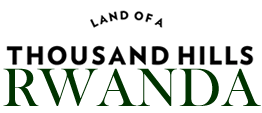The traditional Ballet of Rwanda is one of Africas longest established and least exposed musical traditions. The use of the word Ballet is a product of Belgian colonial rule. In fact, the art form was refined over centuries in the courts of the Rwandan Mwami (kings).
There are three main components to Rwandan Ballet, and a standard performance by a group will contain all three. These are the songs/dances that are the essence of the art form (and are referred to here as ‘the Ballet’), Intore (dance of heroes) and Ingoma (‘drums’).
The ‘Dance of Heroes’ is performed by men wearing grass wigs and carrying spears. The background is a dance performed by returning warriors, celebrating victory in battle. The dancers move from side to side combining grace and complex choreography with a raw aggression. At certain stages the dancers stop, with arms outstretched and make blood-curdling battle crys.
These calls are individual to each dancer and represent warriors declaiming the details of how many he had slain in battle. Battles traditionally involved Hutu, Tutsi and Twa fighting alongside each-other against a common enemy. The performance of Intore therefore has always consisted of warriors of all groups dancing together.
A visit to Rwanda is not complete without seeing a dance by the Intore Dancers, the dance form took shape in the courts of Rwandan Mwami(The King), it is generally a story telling dance, in which stories of love, war and time of hard ship are put into a dance form. It is more like an opera than a ballet as some Belgian’s termed it. It can not be termed as a battle dance alone because, it is performed in different scenarios, it was also performed after winning a battle.
The actual meaning of the term Intore is “the chosen ones”, so basically it was the dance of the chosen ones.
Intore dancers have gained a worldwide status of fame and have become an indispensable part of the Rwandan culture and tradition. The Intore dancers gained popularity in the year 1958 during the World Expo which was held in Brussels. This form of traditional Rwanda ballet is one of the ancient forms of dancing in Africa. The Intore dancing is also known as “warrior dancing”.
The Intore people, who were once regarded as part of the traditional Rwanda army, were not only given military training but also taught the technique of high jumps and dancing. They were known for their outstanding method of jumping with the help of which they could rise up to 2,40 meters from the ground.
There are three main parts of the Rwandan ballet which comprise of Ingoma, Intore dancers and the songs. During the performance, Intore dancers, especially men wear grass wigs and have spears in their hands. They wear little bells on each foot which gives a rhythm to the entire background music. The theme of the performance is the celebration of victory in a battle which is depicted through the medium of dancing. The Intore dancers move sideways combining difficult choreography and grace with a raw aggressiveness in their expressions. At one point, the dancers stop, with stretched arms and give out blood-curdling battle cries. Throughout the ballet, physical quarrel between the dancers turns into a form of artistic rivalry and at the end of the performance they hug each other as a symbol of friendship.
The most common traditional battles include Tutsi, Hutu and Twa fights against a familiar opponent. The performance of Intore dancers is always associated with the idea of power, raw masculinity, aggressiveness and yet as a tradition of the cultural heritage of Rwanda.
